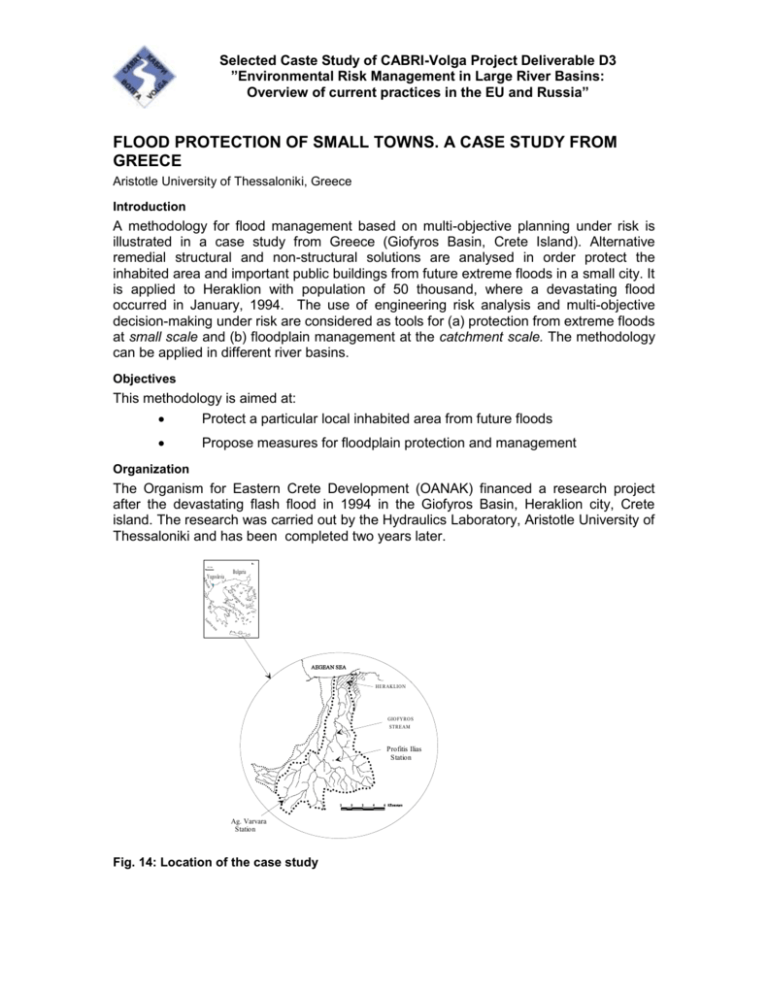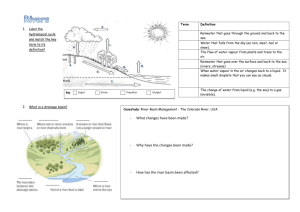flood protection of small towns - CABRI
advertisement

Selected Caste Study of CABRI-Volga Project Deliverable D3 ”Environmental Risk Management in Large River Basins: Overview of current practices in the EU and Russia” FLOOD PROTECTION OF SMALL TOWNS. A CASE STUDY FROM GREECE Aristotle University of Thessaloniki, Greece Introduction A methodology for flood management based on multi-objective planning under risk is illustrated in a case study from Greece (Giofyros Basin, Crete Island). Alternative remedial structural and non-structural solutions are analysed in order protect the inhabited area and important public buildings from future extreme floods in a small city. It is applied to Heraklion with population of 50 thousand, where a devastating flood occurred in January, 1994. The use of engineering risk analysis and multi-objective decision-making under risk are considered as tools for (a) protection from extreme floods at small scale and (b) floodplain management at the catchment scale. The methodology can be applied in different river basins. Objectives This methodology is aimed at: Protect a particular local inhabited area from future floods Propose measures for floodplain protection and management Organization The Organism for Eastern Crete Development (OANAK) financed a research project after the devastating flash flood in 1994 in the Giofyros Basin, Heraklion city, Crete island. The research was carried out by the Hydraulics Laboratory, Aristotle University of Thessaloniki and has been completed two years later. N 100 Km Alb Yugoslavia Bulgaria an ia ni on se ea n y Io eg T ur ke A se a a HERAKLIO N GIOFYROS STREAM Profitis Ilias Station Ag. Varvara Station Fig. 14: Location of the case study Selected Caste Study of CABRI-Volga Project Deliverable D3 ”Environmental Risk Management in Large River Basins: Overview of current practices in the EU and Russia” Present stage of implementation Dikes to protect public property in the area of wastewater treatment plant of the city of Heraklion have been constructed. This area was affected by the 1994 flood. Storm retention reservoirs in the upstream catchment area under construction Results On 13th January 1994, a devastating flood occurred in the Giofyros basin. The extreme flood resulted in a series of events, which may be summarised as follows: Heavy rainfall. The total rainfall recorded on the day of the flood was about 185 mm, which is equal to about half of the mean annual precipitation in the region of Heraklion. A maximum rainfall intensity of 37 mm/h was recorded at the hydro-meteorological station of Aghia Varvara (Fig. 11). In 6 hours, which is about the retention time for the Giofyros basin, a total rainfall of 143 mm was recorded. Rainfall of a light intensity had persisted several days before the critical storm of 13th January 1994. The soil was almost completely saturated and runoff was high during the critical storm. Deforestation and the removal of several hectares of vineyards during the months preceding the storm probably also influenced the increased intensity of the flood. Many houses located downstream, near the coast, were flooded and material damage was evaluated at several hundreds of thousands of Euros. The most important effect of the flood was the damage caused to the city’s wastewater treatment plant, which was still under construction at the time. Many of the plant’s reservoirs, made of concrete, were rendered unserviceable or completely destroyed by the force of the incoming water. Selected Caste Study of CABRI-Volga Project Deliverable D3 ”Environmental Risk Management in Large River Basins: Overview of current practices in the EU and Russia” 40 35 i(mm/ h) 30 25 20 15 10 5 0 0 5 10 15 20 25 Time t(h) Fig. 15: Rainfall intensity i (mm/h) versus duration t (h) between 13-14 January, 1994 Distinction is made between the local scale of protection from floods. and the catchment scale planning. On the local scale, reliability of the protection measures were based on more traditional techniques involving hydrological and hydraulic modelling of twodimensional unsteady flows (Fig. below). (St Venant equations, Ganoulis, 2003). Selected Caste Study of CABRI-Volga Project Deliverable D3 ”Environmental Risk Management in Large River Basins: Overview of current practices in the EU and Russia” Fig. 16: Contour lines of water stage for the 1994 flood (no flood levees around the wastewater treatment plant.) On the catchment scale, a multi-criteria trade-off approach was used for choosing between different alternatives. Multi-objective risk-based flood management methodologies for protection measures resulted in trade-offs between risk and costs, as well as between environmental and social impacts (Ganoulis, 2003). By combining three structural solutions, the following 5 alternatives were investigated: Regulation of the downstream part of the river (R) and construction of a large reservoir (LR) (R) + Construction of a small capacity reservoir (SR) (R) + Storm Detention Basin network of T=30-yr floods (DB30) (R) + Storm Detention Basin network of T=50-yr floods (DB50) (R) + Storm Detention Basin network of T=100-yr floods (DB100) The principal function of a storm detention basin network distributed over the tributaries of the main stream is to reduce the peaks of the floods hydrographs. At the same time, significant volumes of water may be retained locally for agricultural purposes Concluding Observations The main objectives for ranking the above 5 alternatives are: (1) costs and benefits, (2) risk of failure, (3) environmental impact, and (4) social effects. Alternative No 3 resulted as the most appropriate for satisfying the multiple objectives. In areas without too many constraints (e.g. high population or intensive agriculture) a storm detention basin system distributed over the entire catchment area seems to be the most appropriate from technical, economical, environmental and social point of views.






![My Flood Project [WORD 624KB]](http://s3.studylib.net/store/data/007180649_1-37937117fa0d9f223031a6f75d9a4179-300x300.png)
